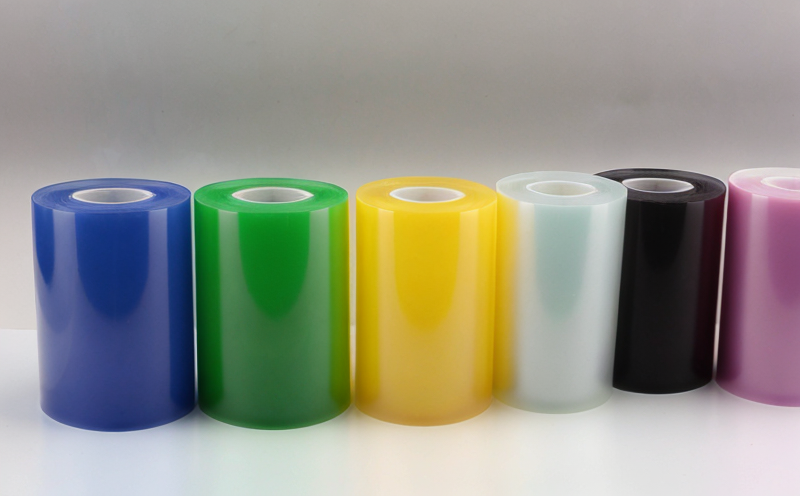EN ISO 4895 Chemical Resistance Testing of Plastic Sheets
The EN ISO 4895 standard is a critical tool in ensuring that plastic sheets and films are capable of withstanding exposure to various chemicals without compromising their physical or chemical properties. This test evaluates the resistance of polymer materials to immersion, spraying, or contact with different solvents, acids, bases, and other chemicals. The result provides manufacturers, quality managers, and compliance officers with essential data needed for product development, material selection, and regulatory compliance.
The importance of this testing cannot be overstated in various sectors including packaging, automotive, electronics, and construction where plastic sheets are used extensively. For instance, in the food industry, it's crucial to ensure that packaging materials do not leach harmful chemicals into the contents they contain. In the medical sector, the integrity of surgical drapes or other disposable products is paramount to patient safety.
The testing process involves exposing samples cut from plastic sheets according to specific dimensions and tolerances defined in the standard. The specimens are then immersed or sprayed with a series of chemical solutions for varying durations, depending on the test's purpose and requirements. After exposure, the samples undergo a battery of mechanical tests such as tensile strength, elongation at break, and impact resistance to assess any changes caused by the chemicals.
One key aspect of this testing is the selection of appropriate solvents or other chemical agents for exposure. The choice depends on the intended use of the plastic sheet in real-world applications. For example, if a sheet is destined for packaging food items, it might be tested against common household cleaning agents and water to ensure it does not contaminate the contents.
The acceptance criteria are defined by the standard itself, which specifies the allowable changes in properties such as tensile strength or elongation at break. If these changes fall within an acceptable range, the plastic sheet is deemed chemically resistant according to EN ISO 4895. This ensures that products meet not only functional but also safety and regulatory requirements.
The application of this standard extends beyond mere compliance; it contributes significantly to innovation in materials science. By understanding how different chemicals interact with polymer sheets, researchers can develop more durable, versatile, and safer materials for various industries.
| Chemical | Type | Testing Duration (hours) | Purpose |
|---|---|---|---|
| Sodium Hydroxide | Basis of the test | 24 | Assess resistance to basic solutions. |
| Ethanol | Solvent | 168 | Determine compatibility with common solvents. |
| Test Condition | Temperature (°C) | Relative Humidity (%) | Purpose |
|---|---|---|---|
| Immersion Test | 23 ± 2 | 50 ± 10 | Evaluate long-term immersion effects. |
| Spraying Test | 23 ± 2 | 65 ± 5 | Assess immediate spray impacts on materials. |
The process also involves careful specimen preparation, which includes cutting the plastic sheets to specific dimensions and tolerances. This ensures that all samples are consistent in size and shape, providing accurate and reliable test results. The testing environment must be strictly controlled, with temperature and humidity levels maintained within specified parameters.
Understanding the chemical resistance of polymer materials is essential for material selection in diverse industries. For quality managers and compliance officers, this standard offers a robust framework to ensure product safety and regulatory compliance. R&D engineers can rely on these test results to innovate new materials or improve existing ones. Procurement teams benefit from knowing that suppliers adhere to high-quality standards.
Applied Standards
The EN ISO 4895 standard is widely used in the polymer and plastics industry for assessing chemical resistance. This standard ensures that plastic sheets are evaluated under controlled conditions, making it a reliable tool for material selection and quality assurance. The applied standards include:
- EN ISO 4895-1:2018 - Immersion Tests
- EN ISO 4895-2:2017 - Spraying Tests
The standard provides clear guidelines on the testing procedures, specimen preparation, and evaluation criteria. These guidelines ensure that all tests are conducted consistently across different laboratories and industries.
Why Choose This Test
Choosing EN ISO 4895 chemical resistance testing offers several advantages for manufacturers and quality managers:
- Compliance with International Standards: Ensures that products meet global regulatory requirements.
- Enhanced Product Quality: Identifies potential issues early in the development process, leading to improved product performance.
- Innovation Opportunities: Provides insights into material behavior under various chemical exposures, driving innovation in polymer science.
- Customer Satisfaction: Ensures that products meet or exceed customer expectations regarding safety and durability.
The test is particularly beneficial for industries where materials are exposed to chemicals during use. By ensuring chemical resistance, the test helps prevent contamination and degradation of products, enhancing their longevity and reliability.
Competitive Advantage and Market Impact
Choosing EN ISO 4895 chemical resistance testing offers several competitive advantages:
- Innovation: Insights into material behavior under various chemical exposures can drive innovation in polymer science.
- Consistency: Ensures consistent product quality across different batches or suppliers.
- Regulatory Compliance: Helps manufacturers meet international standards and regulatory requirements, opening up new markets.
- Customer Satisfaction: Enhances customer confidence by ensuring product safety and durability.
The impact on the market is profound. By ensuring chemical resistance, this test helps prevent contamination and degradation of products, enhancing their longevity and reliability. This can lead to increased sales and customer loyalty in competitive markets.





